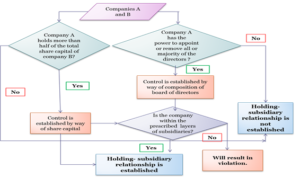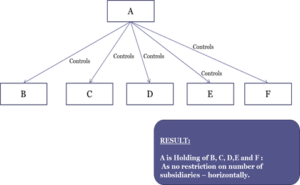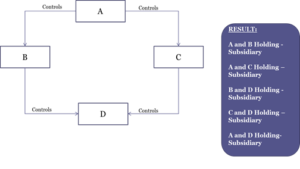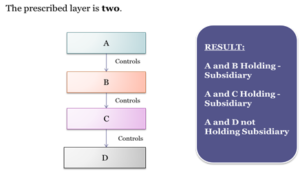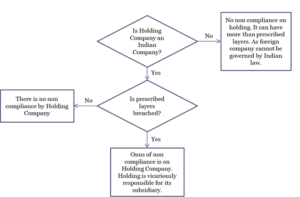MCA concerned on siphoning of funds, proposes limit of two layers of subsidiaries
CS Vinita Nair, corplaw@vinodkothari.com
MCA vide public notice dated[1] June 28, 2017 has conveyed its intent of issuing a notification proposing amendments to the Companies (Specification of Definitions Details) Rules, 2014 containing the restriction on layers of subsidiaries beyond prescribed number and has invited suggestions on the draft notification. Comments/suggestions on the draft rules along with justifications in brief may be sent latest by 20th July, 2017 through email at csddar@mca.gov.in in the format prescribed.
Proviso to Section 2 (87) along with explanation (d) was proposed to be omitted in Companies (Amendment) Bill, 2016. However, in view of reports of misuse of multiple layers of companies, where companies create shell companies for diversion of funds or money laundering , MCA has decided to retain the provisions and commence the aforesaid proviso and explanation. Further, MCA has no intent to exempt private companies from the requirement as well. Similar restriction on number of layers of investment companies has already been in force under Section 186 (1).
It is important to note that even body corporate will get covered as the expression ‘company’ includes body corporate for the purpose of Section 2 (87).
Figure 5 of Taxmann’s Your Queries on Companies Act, 2013
[1] http://www.mca.gov.in/Ministry/pdf/Notice_29062017.pdf
This write up initially discusses the proposed conditions and thereafter analyses the permitted combinations.
Exempted companies
Provisions of the proposed rule 5 shall not apply to following classes of companies, namely:-
(a) a banking company;
(b) a non-banking financial company as defined in the Reserve Bank of India Act, 1934 (2 of 1934) which is registered with the Reserve Bank of India and considered as systemically important non-banking financial company by the Reserve Bank of India; (Nothing specified in relation to housing finance companies/ NBFC CICs).
(c) an insurance company being a company which carries on the business of insurance in accordance with provisions of Insurance Act, 1938 and Insurance Regulatory Development Authority Act, 1999;
(d) a Government company referred to in clause (45) of section 2 of the Act.
It is necessary to extend to exemptions in cases of Housing Finance Companies, Core Investment Companies as well as Non-Operative Financial Holding Company .
Exempted subsidiaries
The proposed Rule 5 (1) shall not apply to one layer of wholly owned subsidiary. Further, the provisions of this sub-rule shall not affect a holding company from acquiring a subsidiary incorporated in a country outside India if such subsidiary has subsidiaries as per the laws of such country.
Given the intent behind enforcing the provisions, it is necessary to exempt such subsidiaries where there is no fund infusion and mere control of management. Subsidiaries by virtue of Section 2 (87) (i) only and not by virtue of Section 2 (87) (ii) should also be exempted.
The exemption in case of acquiring of subsidiaries incorporated outside India should extend equally to subsidiaries incorporated outside India. There need not be a distinction in acquisition and incorporation of subsidiary outside India.
Proposed amendment to be prospective in nature
The holding companies, other than exempted companies, that breach the conditions of layers of subsidiaries as on the date of commencement of provision will be prohibited from incorporating additional layer of subsidiaries.
Such holding companies shall file return in Form SDD-1 with the Registrar within a period of three months from the date of its deployment as an electronic form on the Ministry’s MCA-21 portal. The proposed form requires specifying layer number of the subsidiary and percentage of shares held by holding company.
No restriction on horizontal propagation
All the below mentioned structures are permitted and well in compliance
Figure 9 of Taxmann’s Your Queries on Companies Act, 2013
Figure 9 of Taxmann’s Your Queries on Companies Act, 2013
Permitted and prohibited combinations
Case 1:
Figure 8 of Taxmann’s Your Queries on Companies Act, 2013
In the aforesaid structure, if we consider on as is basis, there exists more than 2 layers of subsidiaries. Therefore, an existing company cannot go beyond ‘D’. Once the provisions are enforced, an existing holding company A will not be able to float ‘D’ unless any exemptions/ relaxations become applicable.
Case 2 – ‘B’/’C’/ ‘D’[1] is a wholly owned subsidiary of ‘A’:
In that case, the structure is permissible.
Case 3 – ‘B’/’C’ is a subsidiary incorporated outside India:
Currently, the wording of draft rule prescribes ‘acquired’ subsidiaries to be exempted. However, the benefit should be extended to subsidiaries incorporated outside India.
Case 4 – ‘B” is a subsidiary acquired outside India while ‘C’ and ‘D’ and subsidiaries of ‘B’ incorporated in India
So ‘A’, ‘C’ and “D’ are companies incorporated in India while ‘B’ is a subsidiary outside India. The exemption cannot be extended to ‘C’ and ‘D’ merely because it’s immediately holding company is a subsidiary acquired outside India. Therefore, the limit is likely to be breached unless ‘B’ or ‘C’ or ‘D’ is a wholly owned subsidiary.
Case 5 – ‘A’/‘B’/’C’ fall under exempted companies:
In that case, the restriction shall not apply.
Case 6 – ‘B’/’C’/ ‘D’ is an LLP:
The expression ‘company’ includes body corporate. Therefore, an existing company cannot go beyond ‘D’. Once the provisions are enforced, an existing holding company A will not be able to float ‘D’ unless any exemptions/ relaxations become applicable.
Onus of non-compliance
Figure 7 of Taxmann’s Your Queries on Companies Act, 2013

